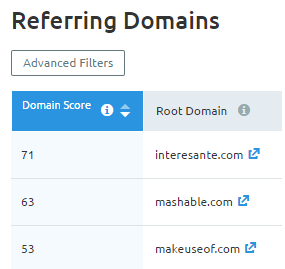What Is a Backlink Analysis?
One of the most important elements is backlinks, or the links from other sites that point to your site. Search engines like Google view these links as a sign of your site’s quality and authority, and the more you have from other reputable sites, the higher you’ll rank.
This means that building links is essential for SEO, and doing so effectively requires a strong understanding of your existing links and information about your competitors’ links.
A backlink analysis provides all of this information. On this page, we’ll go over what that means and how you can conduct your first one. You can also contact us online or call 888-601-5359 today to speak with one of our experts!
Good agencies have more than 50 testimonials.
Great agencies have more than 100 testimonials.
WebFX has over 1,100+ glowing client testimonials.
See What Makes Us Stand out

What is a backlink analysis?
A backlink analysis is an evaluation of the volume and quality of links pointing to your website from other sites. Analyzing your site’s backlinks helps you determine how those links impact your search engine rankings and what you can do to improve your backlink profile.
Why should you conduct a backlink analysis?
Search engines view links as indicators of your site’s authority, which makes backlinks important to SEO. A backlink analysis shows you all the links that they’re taking into consideration and gives you a better understanding of your site’s ability to rank well in search engine results.
Backlink analysis also helps you identify bad links. Links that are unnatural or from spammy sites can result in a Google penalty, but finding and disavowing them keeps your site reputable.
However, your site isn’t the only one you should analyze. You should also conduct backlink analysis on your main competitors’ sites.
Analyzing your competitors’ sites will help you see how difficult it will be to outrank them. It can also show you any potential link opportunities you may be missing and give you ideas for your own link building strategy.
How to conduct backlink analysis
If you’ve never done backlink analysis on your site or your competitors’, there are a few basic steps you can take to get started:
1. Choose the sites you want to analyze
The first step to backlink analysis is selecting which sites you want to analyze. Your own site should be your first priority, but from there, you may need to do a little research.
You likely already know who your main competitors are. If you’re a local business, they’re the other businesses in your area offering similar services. If you’re an ecommerce retailer, they’re other sites selling the same products. These sites should be priorities on your list.
From there, you can identify possible competitors with a few quick Google searches. Type your top target keywords into the search bar and look at the sites that rank for them. These are the sites you’re ultimately trying to outrank, and analyzing their backlink profiles will show you where and how you can outdo them.
Depending on the tool you use, you may also be able to access a list of sites competing for the same organic keywords.
SEMrush, for example, provides a list of main organic competitors based on the number of organic keywords any two sites rank for.

2. Select a backlink analysis tool
Once you’ve selected the sites you want to research, choose which research tools you want to use. This is largely a matter of preference, but some of the most popular options are:
These are paid tools, but all of them offer some variation of a free trial, so we recommend trying them all for your first backlink analysis and deciding which is the best fit for your needs.
You can use these tools to monitor your number of backlinks and view your backlink profile. And some tools, like Semrush, enable you to run a backlink audit on your site and disavow links that may be harmful to your SEO.
However, it’s important to note that some tools, like Semrush, tend to be overly aggressive with the disavow files they generate and often include links that aren’t necessary to disavow. If you disavow the wrong links, you can risk harming your backlink profile.
Google recommends only submitting a disavow file if you have a penalty AND had an influx of spammy links that you paid for. If neither of these pertain to you, don’t disavow links.
At WebFX, we use all three to conduct comprehensive analysis for both our site and our clients’. However, if you’re just starting out, any one of these tools will be able to provide you with enough information for you to make an informed decision.
3. Enter each domain and collect the information you want
After you’ve selected your sites and a research tool, type each domain into your chosen tool and start collecting information. We’ll discuss the exact metrics you should use for each site in the next section, but it’s important that you have a plan for recording everything as you go along.
Conducting backlink analysis involves sifting through a lot of data, and unless you keep track of it, you won’t be able to use it to make informed decisions about your Internet marketing strategy.
That being said, your tracking method doesn’t have to be complicated. An Excel spreadsheet or Google Sheet will be enough.
We foster and form long-term partnerships so that your business has long-term results.
Over 90%
What should you look for in a backlink analysis?

Like many online analytics tools, backlink analysis provides you with a wealth of information. And while all of this information is useful one way or another, it would be overwhelming – not to mention time-consuming – to look at all of it.
That means you should pick out a few key pieces of information to track on each site you analyze. The ones you choose are up to you, but at the very least, we recommend these three:
1. Total number of links & unique domains
One of the most basic metrics is the total number of backlinks pointing to a site. Comparing this number for your site to a competitor gives you a general idea of how you your sites compare in terms of authority.
You should also take a look at the number of referring domains. This number tells you how many unique sites link to any given site. For example, if a site has 1000 total backlinks and 600 referring domains, 400 of their links are from sites that already link to them.
Having fewer referring domains than total backlinks is normal, and it’s not a bad sign. However, your goal should be to have a diverse link profile with lots of domains, so getting links from sites that already link to yours isn’t as valuable as getting links from new sites.

2. Referring domains
Along with the number of referring domains, you should also look at those domains close-up.
For your own site, this can give you an idea of where your most valuable links are and which content on your site they point to.
When looking at your competitors, this information is even more valuable. Looking at these domains allows you to identify link opportunities for your own site – after all, if they linked to one of your competitors, there’s a chance they’ll link to you, too.
We recommend that you sort these domains by their authority, or “domain score” as it’s called it Semrush, and compile a list of authoritative sites that link to your competitors. You can keep this list for reference as you later create new content and search for outreach opportunities.
If you’re looking for Semrush alternatives, check out this breakdown of Semrush vs. SpyFu.
3. Top pages
Finally, look at which pages on your site (and your competitors’) have the most links pointing to them.

In most cases, the top page will always be your home page. If your company is ever mentioned in a news article or cited as a source, this is almost always where the link will point.
Beyond that, you can see which pages have the most links. If you’ve ever done outreach for any of your specific pages, you’ll see them near the top of your list.
From there, you can look over popular pages to see if any type of content works best for building links to your site. If you’ve published original research, for example, and notice lots of links pointing to that page, that indicates that publishing more original research would be a wise choice for your link building strategy.
If you see that pages on a particular topic have received the most links, that means that it’s most likely a safe bet to continue researching and writing about that topic.
Analyzing your competitors’ top pages is often more informative than your own. Look over the pages on each competitor’s site, and you’ll see what types of content are the most valuable to their link building strategy.
For example, let’s say one of your top competitors has built several links to a case study on their site. If you’ve never published a case study, this is a clear sign that it would be worth your time to write and publish one.
These top pages serve as general ideas for your link building strategy than specific topic ideas. After all, if you write an article on the exact same topic as one of your competitors, it’s unlikely that you’ll succeed.
News sites and bloggers don’t link to sites just for the sake of links – you need to offer something unique and interesting. This means you’ll be much more successful if you use your competitors’ pages as inspiration for content, but take a different angle or use your own original research.
Ready to start researching your competitors?
Backlink analysis is essential for any SEO strategy, and when done right, it gives you valuable insight into both your site and your competitors’. If you’d like to work with a professional, WebFX can help.
We conduct thorough backlink analysis for all of our clients to help them create an effective link building strategy, and we’ll do the same for you.
Contact us today for more information or a free quote!
Related Resources
- How to Build Your Very First Link
- How to Create a Backlink: 7 Fool-Proof Ways to Earn Backlinks
- Notorious S.E.O.: the 10 Crack Commandments of Link Building
- What Are Backlinks?
- What is Earned Media?
- What is Off-Page SEO?
- Why Are Backlinks Important for SEO and How Can You Earn Them?
- Your Off-Page SEO Checklist for Ranking Higher
- Earning Backlinks in Real Life: 5 Links Every Small Business Should Have
- How Many Backlinks Does Your Site Need?
Marketing Tips for Niche Industries
- Top-of-the-Line SEO Services for Health Insurance Companies
- Tourism SEO: 3 Tips for Getting Started
- Turn Online Searches into Sales with SEO for Flooring Companies
- Urgent Care SEO & SEO Services
- Why Long-Tail Keywords Are Important for Electricians
- Why SEO for Museums Matters
- Why Your Grocery Store Needs SEO
- Your Guide to Long Tail Keywords for Dentists
- Your Intro to Digital Marketing for Metal Fabricators

Optimize Your Website Faster with SEO.com
Effortlessly find opportunities and monitor performance with this user-friendly tool designed by the SEO experts at WebFX!
Try it for Free










